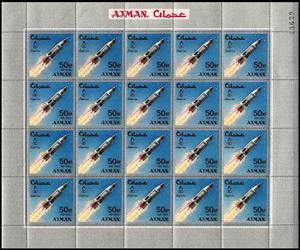Full Pane: Atlas Launch Vehicle (Ajman 1966)
Atlas Launch Vehicle (Ajman 1966)
23 July (Ajman ) within release Space Research (1966) goes into circulation Full Pane Atlas Launch Vehicle face value 20*50 Gulf naye paise
| Full Pane Atlas Launch Vehicle in catalogues | |
|---|---|
| Colnect codes: | Col: AJ 1966.07.23-07b |
Full Pane is square format.
Not explicitely listed by MichelAlso in the issue Space Research (1966):
- Full Pane - Atlas Launch Vehicle face value 20*50;
- Full Pane - Atlas Launch Vehicle face value 20*50;
- Full Pane - Atlas Rocket face value 20*1;
- Full Pane - Atlas Rocket face value 20*1;
- Full Pane - E. H. White Spacewalk (Gemini 4) face value 20*3;
- Full Pane - E. H. White Spacewalk (Gemini 4) face value 20*3;
- Full Pane - E.H. White and McDivitt, Globe, Orbits face value 20*15;
- Full Pane - E.H. White and McDivitt, Globe, Orbits face value 20*15;
- Full Pane - EH White and J McDivitt, Earth Globe with Orbits face value 20*1;
- Full Pane - EH White and J McDivitt, Earth Globe with Orbits face value 20*1;
- Full Pane - Gemini space capsules (Rendezvous) face value 20*3;
- Full Pane - Gemini space capsules (Rendezvous) face value 20*3;
- Full Pane - Gemini space capsules (Rendezvous) face value 20*5;
- Full Pane - Gemini space capsules (Rendezvous) face value 20*5;
- Full Pane - Spacewalk E.H. White (Gemini 4) face value 20*10;
- Full Pane - Spacewalk E.H. White (Gemini 4) face value 20*10;
- Full Pane - Spacewalk E.H. White (Gemini 4) face value 20*25;
- Full Pane - Spacewalk E.H. White (Gemini 4) face value 20*25;
- Full Pane - Test Space Suit (Gemini Program) face value 20*5;
- Full Pane - Test Space Suit (Gemini Program) face value 20*5;
Full Pane Atlas Launch Vehicle it reflects the thematic directions:
Outer space (or simply space) is the expanse that exists beyond Earth's atmosphere and between celestial bodies. It contains ultra-low levels of particle densities, constituting a near-perfect vacuum of predominantly hydrogen and helium plasma, permeated by electromagnetic radiation, cosmic rays, neutrinos, magnetic fields and dust. The baseline temperature of outer space, as set by the background radiation from the Big Bang, is 2.7 kelvins (−270 °C; −455 °F)
A rocket (from Italian: rocchetto, lit. 'bobbin/spool') is a vehicle that uses jet propulsion to accelerate without using any surrounding air. A rocket engine produces thrust by reaction to exhaust expelled at high speed. Rocket engines work entirely from propellant carried within the vehicle; therefore a rocket can fly in the vacuum of space. Rockets work more efficiently in a vacuum and incur a loss of thrust due to the opposing pressure of the atmosphere.
A spacecraft is a vehicle that is designed to fly and operate in outer space. Spacecraft are used for a variety of purposes, including communications, Earth observation, meteorology, navigation, space colonization, planetary exploration, and transportation of humans and cargo. All spacecraft except single-stage-to-orbit vehicles cannot get into space on their own, and require a launch vehicle (carrier rocket).




